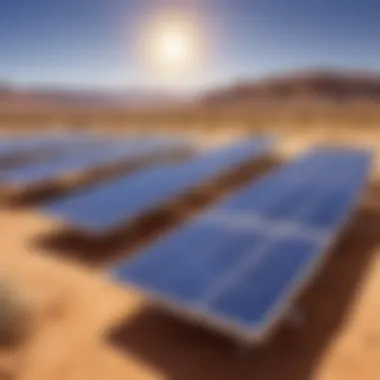The Intriguing World of Diverse Energy Sources Unveiled


Science Fun Facts
As we embark on the journey to uncover the various sources of energy that drive our modern world, it is essential to delve into some fascinating science fun facts that will intrigue curious minds. Did you know that the sun provides enough energy to power the entire Earth for one year in just one hour? This mind-boggling reality showcases the immense potential of solar energy as a renewable and sustainable power source. Furthermore, exploring the concept of fossil fuels leads us to ponder over the fact that it takes millions of years for organic matter to transform into coal, oil, or natural gas, underlining the non-renewable nature of these energy resources.
Discover the wonders of a rapidly evolving scientific landscape with a comprehensive exploration of the diverse sources of energy that shape our world's energy ecosystem. From conventional fossil fuels like coal, oil, and natural gas to innovative renewable solutions such as solar, wind, and hydropower, each energy source plays a crucial role in meeting global energy demands while impacting the environment differently. Understanding the significance and environmental implications of each energy source empowers us to make informed decisions about our energy consumption patterns and strive towards a more sustainable future.
Dive deep into the realm of energy sources with an engaging science quiz time that challenges your knowledge and critical thinking skills. Test your understanding of energy concepts, environmental impacts, and sustainable practices through interactive quizzes, brain teasers, and puzzles. Engaging in learning through gamification not only makes the educational process enjoyable but also enriches your comprehension of complex scientific topics, fostering a culture of curiosity and inquiry.
Unveil the magic of science through a captivating science experiment showcase that brings energy concepts to life through hands-on exploration. Engage in fun and engaging experiments that demonstrate the principles behind energy generation, consumption, and conservation. With detailed step-by-step instructions, a materials list, and safety tips provided, embarking on these scientific experiments offers a safe and immersive learning experience for young minds eager to discover the wonders of energy sources.
Introduction
Energy is the lifeblood of modern society, fueling our homes, industries, and technologies. This article undertakes a vital exploration of the myriad sources of energy that power our world. From the age-old fossil fuels to the innovative renewable options, the investigation delves deep into the significance and impact of each energy source, offering a nuanced perspective on our energy landscape.
Defining Energy Sources
When we talk about energy sources, we refer to the origins from which we derive the power to sustain our activities. Energy sources can be categorized into conventional and renewable sources. Conventional sources include fossil fuels like coal, oil, and gas, while renewable sources encompass solar, wind, geothermal, biomass, and more. Understanding these sources is fundamental in gauging their sustainability, environmental impact, and long-term viability for meeting our energy needs.
Conventional Energy Sources
Conventional energy sources play a pivotal role in powering our modern world. They are fundamental to our daily lives and industrial processes. The significance of conventional energy lies in its widespread availability and reliability. These sources, such as fossil fuels, nuclear energy, and hydropower, have been the primary drivers of economic growth and technological advancement.
Fossil Fuels
Fossil fuels, including coal, oil, and natural gas, have been the cornerstone of global energy production for centuries. However, their use comes at a significant cost to the environment. The Impact on Environment is a critical aspect to consider when discussing fossil fuels. The extraction, processing, and combustion of fossil fuels release greenhouse gases, leading to air and water pollution, and contributing to climate change. Despite these drawbacks, the abundance and energy density of fossil fuels make them attractive for energy generation.
Moreover, Sustainability Concerns surrounding fossil fuels revolve around their finite nature and harmful environmental effects. The depletion of fossil fuel reserves raises concerns about future energy security. Transitioning to sustainable alternatives becomes imperative to mitigate the adverse impacts of fossil fuel consumption. While fossil fuels remain a dominant energy source, the urgent need for sustainable energy practices is clear.


Nuclear Energy
Nuclear energy offers a concentrated and reliable power source with low greenhouse gas emissions. Evaluating the Pros and Cons of nuclear energy is crucial to understanding its role in the energy mix. The Pros include large-scale energy production, relatively low carbon emissions, and energy independence. However, the Cons encompass safety risks, radioactive waste disposal, and the potential for nuclear accidents.
Furthermore, Waste Management in nuclear energy operations is a vital consideration. The safe disposal and long-term storage of radioactive waste necessitate robust protocols to prevent environmental contamination. Implementing effective waste management strategies is essential for ensuring the sustainability and safety of nuclear energy as a power generation option.
Hydropower
Hydropower harnesses the energy of flowing water to generate electricity efficiently. Understanding the Working Mechanism of hydropower plants elucidates their operational dynamics. By directing water flow through turbines, hydropower converts kinetic energy into electrical power, offering a renewable and cost-effective energy source.
Additionally, examining the Environmental Impact of hydropower projects reveals both benefits and drawbacks. While hydropower produces clean electricity with minimal greenhouse gas emissions, it can disrupt river ecosystems and cause habitat loss. Balancing the advantages of hydropower with its environmental consequences is essential for sustainable energy development.
Renewable Energy Sources
Renewable energy sources are a crucial focus in the discussion of energy alternatives. Their importance lies in their sustainable nature, which aids in reducing the dependency on finite resources and lessening environmental impact. Renewable sources such as solar, wind, geothermal, biomass, and hydrogen fuel cells offer significant benefits like lower emissions, energy security, and potential cost-effectiveness. Each source presents unique considerations regarding efficiency, reliability, and environmental compatibility, making them indispensable in the quest for a greener energy mix.
Solar Energy
Photovoltaic Cells
Photovoltaic cells are pivotal in converting sunlight into electricity, playing a key role in solar energy harnessing. These cells possess the exceptional ability to generate electricity directly from sunlight, offering a clean and sustainable power source. The efficiency of photovoltaic cells in capturing solar energy makes them a popular choice for sustainable energy solutions. Despite initial costs and intermittent generation, the long-term benefits of photovoltaic cells in reducing greenhouse gas emissions and improving energy security make them a valuable inclusion in renewable energy discussions.
Advantages over Fossil Fuels
Comparing the advantages of solar energy over fossil fuels reveals key benefits that make it an appealing alternative. Solar energy's renewable nature and minimal environmental impact stand out as advantageous features, unlike fossil fuels that contribute significantly to pollution and climate change. The decentralized nature of solar energy production further enhances resilience and energy security, mitigating risks associated with centralized fossil fuel power plants. Additionally, the downward trend in solar panel costs and the potential for off-grid applications offer promising prospects for widespread adoption, marking a significant shift towards cleaner energy production.
Wind Power
Wind power represents a notable renewable energy source that capitalizes on harnessing wind to generate electricity. The distinction between onshore and offshore wind power serves different purposes, with onshore projects often closer to demand centers and offshore installations tapping into stronger and steadier winds. This variety allows for tailored solutions depending on geographic and economic considerations, showcasing the flexibility and scalability of wind power generation.


Onshore vs. Offshore
The debate between onshore and offshore wind power revolves around location advantages, cost-effectiveness, and environmental impact. Onshore wind farms benefit from easier access for maintenance and land availability, while offshore installations capitalize on higher wind speeds and visual aesthetics but face higher installation and maintenance costs. Choosing between the two depends on specific project goals, resource availability, and regulatory frameworks, underscoring the need for a comprehensive evaluation before implementation.
Challenges and Innovations
Navigating the challenges in wind power involves addressing concerns such as intermittency, grid integration, and visual impacts. Innovations in turbine technology, energy storage solutions, and predictive analytics have aimed to improve efficiency and reliability in wind power generation. Overcoming regulatory hurdles, public acceptance, and environmental considerations remain critical to fostering sustainable wind energy development, urging continued innovation and collaboration in the renewable energy sector.
Geothermal Energy
Geothermal energy utilizes Earth's heat to generate electricity and for heating purposes, offering a reliable and consistent energy source. The process of harnessing geothermal heat involves accessing underground reservoirs of steam or hot water, allowing for clean power generation with minimal greenhouse gas emissions. The stability and predictability of geothermal energy make it an attractive option for baseload power, complementing intermittent renewable sources and contributing to a diversified energy portfolio.
Harnessing Earth's Heat
Efficiently extracting heat from the Earth entails drilling wells into geothermal reservoirs and utilizing steam or hot water to drive turbines for electricity generation. This direct use of geothermal resources eliminates the need for combustion, reducing air pollution and carbon emissions associated with traditional fossil-fuel-based power plants. By tapping into the Earth's natural heat reservoirs, geothermal energy presents a sustainable alternative with long-term benefits for energy production and environmental stewardship.
Applications and Sustainability
The applications of geothermal energy extend beyond electricity generation to heating and cooling functions in residential, commercial, and industrial sectors. Geothermal heat pumps offer efficient space conditioning, leveraging the stable temperatures below the Earth's surface for year-round comfort. The sustainability of geothermal energy in reducing emissions, promoting energy independence, and fostering local economic development underscores its viability as a clean and reliable energy source, paving the way for increased adoption and integration within the energy landscape.
Emerging Energy Technologies
Energy is a crucial aspect of our modern society, with emerging technologies playing a pivotal role in shaping the future of energy production and consumption. In this article, we delve into the significance of emerging energy technologies, examining their potential to revolutionize the way we power our world. These advanced technologies offer new opportunities for sustainable energy generation, addressing the challenges posed by traditional energy sources.
Tidal Power
Utilizing Ocean Energy
Tidal power, a form of renewable energy, harnesses the natural ebb and flow of ocean tides to generate electricity. This method utilizes the kinetic energy of moving water masses to produce clean power. The key characteristic of utilizing ocean energy lies in its perpetual nature, as tides are predictable and consistent. This reliability makes it a popular choice for sustainable energy production. However, challenges such as high initial infrastructure costs and limited suitable locations for tidal power plants can impact its widespread adoption.


Potential and Limitations
Examining the potential and limitations of tidal power provides insights into its overall feasibility as an energy source. The vast energy potential of oceans offers a promising avenue for sustainable power generation. Yet, limitations such as environmental impact on marine ecosystems and the need for advanced technological solutions to optimize energy conversion present hurdles to overcome. Understanding both the advantages and disadvantages of tidal power is crucial for its integration into the energy mix.
Wave Energy
Wave-to-Electricity Conversion
Wave energy involves converting the motion of ocean waves into electricity through specialized technologies. This process captures the kinetic energy present in waves and transforms it into a usable form of power. The key characteristic of wave-to-electricity conversion is its renewable nature, as waves are a perpetual energy source. This innovative approach offers a promising solution for clean energy generation. However, challenges related to the intermittent nature of wave energy and the impact of harsh marine conditions on equipment operation must be addressed.
Impact on Marine Ecosystem
Exploring the impact of wave energy on marine ecosystems sheds light on the potential consequences of deploying such technologies. While wave energy is a clean and renewable energy source, its implementation may affect local marine habitats and species. Understanding the advantages and disadvantages of wave energy in relation to marine ecosystems is essential for sustainable development. Mitigating the potential risks and maximizing the benefits of wave energy require careful consideration and environmental stewardship.
Fuel from Algae
Biofuel Production Process
Fuel from algae refers to biofuels derived from algae through a complex production process. Algae, known for their high oil content, can be processed into renewable fuels such as biodiesel. The key characteristic of the biofuel production process from algae is its potential for high yields and minimal land use compared to traditional crops. This method presents a viable alternative to fossil fuels, offering a sustainable energy solution. However, challenges like large-scale cultivation requirements and energy-intensive extraction processes influence its widespread adoption.
Sustainability and Efficiency
Assessing the sustainability and efficiency of algae-derived biofuels is integral to understanding their role in the energy landscape. The eco-friendly nature of algae-based biofuels mitigates greenhouse gas emissions and reduces reliance on fossil fuels. Enhancing the sustainability and efficiency of biofuel production involves optimizing cultivation techniques and extraction methods. Recognizing both the advantages and disadvantages of algae-based biofuels is essential for promoting their growth as a renewable energy source.
Conclusion
In this detailed exploration of various sources of energy, the conclusion serves as a pivotal section that encapsulates the essence of the entire article. Understanding the importance of transitioning towards sustainable energy practices is crucial in shaping the future of our planet. It is evident that traditional energy sources like fossil fuels pose significant environmental risks, including pollution and climate change implications. By contrast, renewable energy alternatives such as solar, wind, geothermal, biomass, and hydrogen offer cleaner and more sustainable solutions for meeting our energy needs.
Highlighting the significance of harnessing renewable energy sources, the conclusion underscores the urgent need for a shift towards sustainability. Emphasizing the benefits of reducing carbon emissions, mitigating environmental impact, and ensuring long-term energy security, this section aims to inspire readers to advocate for renewable energy policies and practices.
Towards a Sustainable Energy Future
The section on 'Towards a Sustainable Energy Future' delves into the critical aspects of transitioning towards more environmentally-friendly energy sources to combat climate change and promote long-term sustainability. Focusing on the imperative of reducing our reliance on fossil fuels and embracing renewable alternatives, this segment examines the benefits, challenges, and considerations associated with this transition.
Analyzing the potential of solar, wind, geothermal, biomass, and hydrogen energy technologies, the narrative explores their capacity to mitigate greenhouse gas emissions, enhance energy efficiency, and foster energy independence. By emphasizing the importance of innovation, investment, and policy support in advancing sustainable energy solutions, this section aims to empower readers to contribute to a greener and more sustainable future for generations to come.







